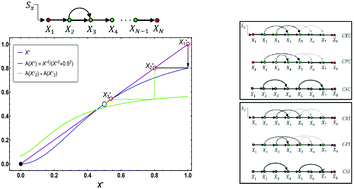当前位置:
X-MOL 学术
›
Phys. Chem. Chem. Phys.
›
论文详情
Our official English website, www.x-mol.net, welcomes your feedback! (Note: you will need to create a separate account there.)
On the role of topology in regulating transcriptional cascades
Physical Chemistry Chemical Physics ( IF 3.3 ) Pub Date : 2017-09-08 00:00:00 , DOI: 10.1039/c7cp02671d Mahan Ghafari 1, 2, 3, 4, 5 , Alireza Mashaghi 1, 2, 3, 4, 5
Physical Chemistry Chemical Physics ( IF 3.3 ) Pub Date : 2017-09-08 00:00:00 , DOI: 10.1039/c7cp02671d Mahan Ghafari 1, 2, 3, 4, 5 , Alireza Mashaghi 1, 2, 3, 4, 5
Affiliation

|
We study the impact of topology on the response of a transcriptional cascade with certain circuit topologies to a constant and time-varying input signal. We systematically analyze the response of the output to activating and repressing cascades. We identify two types of responses for a linear cascade, namely the “Decaying mode”, where the input signal becomes exceedingly weaker as it propagates, and the “Bistable mode”, where the input signal can either be amplified or die out in the pathway. We examine how the transition occurs from one mode to the other as we add coherent and/or incoherent feed-forward loops in an otherwise linear cascade. We find that pathways with at least one incoherent feedforward loop can perform adaptive responses with the quality of response varying among different topologies. Furthermore, we study the origin of a (non)monotonic input–output profile for various circuit topologies over a wide range of parameter space. For a time-varying input signal, we identify some circuit topologies that are more prone to noise propagation than others that are more reliable in blocking out high-amplitude fluctuations. We discuss the effect of cell to cell variation in protein expression on the output of a linear cascade and compare the robustness of activating and repressing cascades to noise propagations. In the end, we apply our model to study an example of a transcription cascade that guides the development of Bacillus subtilis spores and discuss an example from a metabolic pathway where a transition from the decaying to bistable mode can occur by changing the topology of interactions in the pathway.
中文翻译:

论拓扑在调控转录级联反应中的作用
我们研究拓扑对具有一定电路拓扑的转录级联对恒定且随时间变化的输入信号的响应的影响。我们系统地分析了输出对激活和抑制级联的响应。我们确定了线性级联的两种类型的响应,即“衰减模式”和“双稳态模式”,其中输入信号在传播时变得非常弱,而“双稳态”模式中的输入信号可以被放大或消亡。我们检查了在以其他方式线性级联添加相干和/或不相干前馈环路时,如何从一种模式过渡到另一种模式。我们发现具有至少一个非相干前馈环路的路径可以执行自适应响应,并且响应质量在不同拓扑之间有所不同。此外,我们研究了在各种参数空间内各种电路拓扑的(非)单调输入-输出曲线的起源。对于随时间变化的输入信号,我们确定了某些电路拓扑更易于传播噪声,而其他电路拓扑则在阻止高振幅波动方面更可靠。我们讨论了蛋白质表达的细胞间变化对线性级联输出的影响,并比较了激活和抑制级联对噪声传播的鲁棒性。最后,我们运用我们的模型研究了一个转录级联的例子,该例子指导了人的发展。我们确定了某些电路拓扑比其他在阻止高幅度波动方面更可靠的电路拓扑更易于传播噪声。我们讨论了蛋白质表达的细胞间变化对线性级联输出的影响,并比较了激活和抑制级联对噪声传播的鲁棒性。最后,我们将我们的模型应用于指导转录的发展的转录级联的一个例子。我们确定了某些电路拓扑比其他在阻止高幅度波动方面更可靠的电路拓扑更易于传播噪声。我们讨论了蛋白质表达的细胞间变化对线性级联输出的影响,并比较了激活和抑制级联对噪声传播的鲁棒性。最后,我们将我们的模型应用于指导转录的发展的转录级联的一个例子。讨论枯草芽孢杆菌的芽孢,并讨论一个代谢途径的例子,其中可以通过改变途径中相互作用的拓扑结构而发生从衰变模式到双稳态模式的转变。
更新日期:2017-09-20
中文翻译:

论拓扑在调控转录级联反应中的作用
我们研究拓扑对具有一定电路拓扑的转录级联对恒定且随时间变化的输入信号的响应的影响。我们系统地分析了输出对激活和抑制级联的响应。我们确定了线性级联的两种类型的响应,即“衰减模式”和“双稳态模式”,其中输入信号在传播时变得非常弱,而“双稳态”模式中的输入信号可以被放大或消亡。我们检查了在以其他方式线性级联添加相干和/或不相干前馈环路时,如何从一种模式过渡到另一种模式。我们发现具有至少一个非相干前馈环路的路径可以执行自适应响应,并且响应质量在不同拓扑之间有所不同。此外,我们研究了在各种参数空间内各种电路拓扑的(非)单调输入-输出曲线的起源。对于随时间变化的输入信号,我们确定了某些电路拓扑更易于传播噪声,而其他电路拓扑则在阻止高振幅波动方面更可靠。我们讨论了蛋白质表达的细胞间变化对线性级联输出的影响,并比较了激活和抑制级联对噪声传播的鲁棒性。最后,我们运用我们的模型研究了一个转录级联的例子,该例子指导了人的发展。我们确定了某些电路拓扑比其他在阻止高幅度波动方面更可靠的电路拓扑更易于传播噪声。我们讨论了蛋白质表达的细胞间变化对线性级联输出的影响,并比较了激活和抑制级联对噪声传播的鲁棒性。最后,我们将我们的模型应用于指导转录的发展的转录级联的一个例子。我们确定了某些电路拓扑比其他在阻止高幅度波动方面更可靠的电路拓扑更易于传播噪声。我们讨论了蛋白质表达的细胞间变化对线性级联输出的影响,并比较了激活和抑制级联对噪声传播的鲁棒性。最后,我们将我们的模型应用于指导转录的发展的转录级联的一个例子。讨论枯草芽孢杆菌的芽孢,并讨论一个代谢途径的例子,其中可以通过改变途径中相互作用的拓扑结构而发生从衰变模式到双稳态模式的转变。



























 京公网安备 11010802027423号
京公网安备 11010802027423号